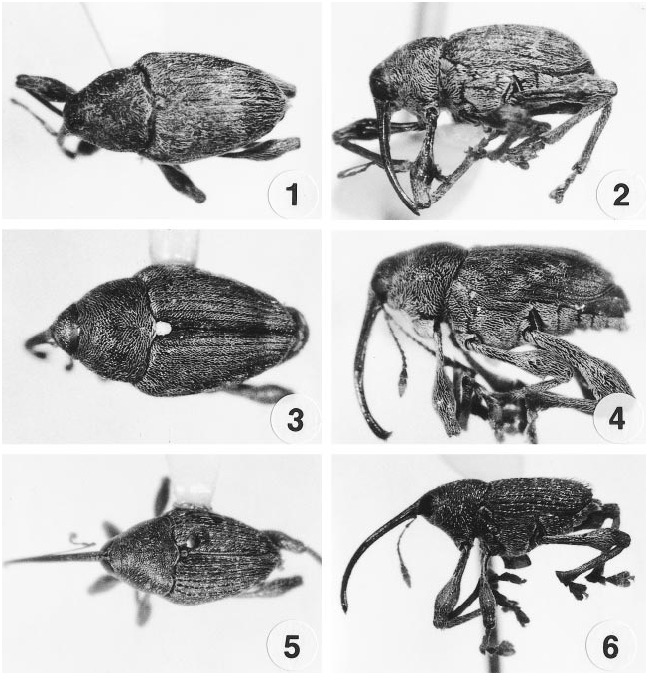Curculio jilinensis Pelsue and Zhang
|
publication ID |
https://doi.org/10.1649/0010-065x(2000)054[0467:arotcf]2.0.co;2 |
|
DOI |
https://doi.org/10.5281/zenodo.15700354 |
|
persistent identifier |
https://treatment.plazi.org/id/8C170A27-B616-946D-FEAB-A745FD32FD90 |
|
treatment provided by |
Carolina |
|
scientific name |
Curculio jilinensis Pelsue and Zhang |
| status |
sp. nov. |
Curculio jilinensis Pelsue and Zhang View in CoL , New Species
Figs. 1–2 View Figs , 33–36 View Figs
HOLOTYPE. China. Jilin: male [China/Jilin/ Hunchun / Y. Zhang] ( IZAS)
PARATYPE. (3) China. Jilin: 2 males, 1 female [China/Jilin/ Hunchun / Y. Zhang] ( FWPC)
Recognition Characters. Elongate oval; derm fuscorufous dorsally on thorax and elytra, piceous laterally and ventrally; frons, 0.24 as wide as head across eyes; rostrum, 0.56 as long as body; scutellum broader than long, clothed with dirty white, scales; femoral teeth small; pro and mesouncus small, metauncus lacking; antennal scape as long as funicle, club as long as segments 4–7.
Description. Male: Length: 3.3–3.8 mm (mean = 3.57) Width: 1.9 mm. Head: Smallsized, moderately convex; punctures small, clothed with small, narrow, elongate, dirty white scales; eyes large, oval, flat and finely faceted; frons moderately broad, 0.24 as wide as head across eyes; sparsely clothed with larger, narrow, elongate, dirty white scales; interocular fovea lacking. Rostrum: Length: 2.0– 2.1 mm (mean = 2.07) 0.56 as long as body; cylindrical, thick at base gradually tapering to apex; margins subparallel to antennal insertion, then gradually tapering to apex; almost straight in lateral view to antennal insertion, then gradually curving to apex; short dorsal carina from frons to smooth dorsal aspect, color from carina to apex, testaceous dorsally, piceous laterally to antennal insertion, then testaceous to apex; two dorsolateral carinae from frons to antennal insertion with oval punctures along and between carinae; scrobe lateral; scape inserted in apical half. Antennae: Length: Scape 1.05 mm. Funiculus: segment one 0.3 mm, two 0.25 mm, three 0.15 mm, four 0.125 mm, five 0.125 mm, six 0.125 mm, seven 0.125 mm, club 0.5 mm. Funicle 1.1 mm; scape as long as funicle; scape and funicle rubiginous, sparsely clothed with elongate, narrow, erect, dirty white scales; club as long as segments 4–7; club elongateoval, with short, dense, fine pile. Thorax: Length: 1.0 mm. Width: 1.3–1.5 mm (mean = 1.37). Dorsally base 0.79 as wide as elytra, lateral margins broadly rounded, tapering abruptly to constriction; disc with punctures small, shallow, separated by narrow ridge, narrow, elongate, dirty, white scales, with bifid and truncated apices, base sinuate with indication of basal carina; mesosternal intercoxal process feeble with narrow, elongate, white scales; scutellum broader than long, bifid, clothed with dirty white scales; mesepimeron, mesepisternum, and metepisternum clothed with clavate, dirty white scales, with truncate apices; procoxae clothed with white scales. Elytra: Length: 2.0– 2.4 mm (mean = 2.24). Striae rather deep, with prominent punctures; humeri feebly prominent, rounded; intervals, broad, flat, with narrow, elongate, white scales mixed with testaceous scales, with no defined macula; crosshatched setae lacking. Legs: Length hind femur: 1.5–1.7 mm (mean = 1.64) tooth small, acute; derm basally and apically fuscopiceous, club fuscorufous; pro and mesofemur with very small tooth; hind femur with proximolateral sulcus from trochanter to base of club; clothed with narrow, elongate, white scales; tibiae somewhat sinuate; pro and mesouncus small, metauncus lacking. Abdomen: Sternite 1 as long as 2 behind coxal cavities; sternite 1 and 2 with broad median declivity; sternite 2 ascending to 3; sternites 3 and 4 combined longer than 5; all sternites evenly clothed with narrow, elongate, white scales; sternite 5 with emarginate apex and 2 tufts of white setalike scales at apex. Pygidium: Small , clothed with elongate, white setalike scales. Genitalia: Median lobe of aedeagus 1.2 mm in length, 0.35 mm in width, narrower at base, slightly widening toward bend, sides narrow, apex arcing down gradually to blunt rounded point, slightly asymmetrical, laterally thickened; apodeme 1.4 mm in length ( Figs. 33–35 View Figs ).
Female: Length: 3.8 mm. Width: 1.9 mm. Rostrum: Length 2.3 mm, scape inserted at midpoint. Antennae: Length: Scape 0.7 mm. Thorax: Length: 1.0 mm. Width: 1.4 mm. Elytra: Length: 2.4 mm. Legs: Length of hind femur 1.8 mm. Genitalia: Spermatheca ramus and collum undifferentiated; cornu broadly thickened, curved to tapered blunt apex ( Fig. 36 View Figs ).
Distribution. China: Jilin Province, Hunchun, Y. Zhang.
Remarks. This species resembles Curculio fluvipennis Morimoto (examined in BMNH collection by senior author) by having a piceous venter, but has a fuscorufous prothorax, elytra, with proximolateral sulcus on the hind femur. Curculio fluvipennis has piceous prothorax, venter, fuscorufous elytra and lacks the proximolateral sulcus on hind femur.
| IZAS |
Institut Zoologii Akademii Nauk Ukraini - Institute of Zoology of the Academy of Sciences of Ukraine |
No known copyright restrictions apply. See Agosti, D., Egloff, W., 2009. Taxonomic information exchange and copyright: the Plazi approach. BMC Research Notes 2009, 2:53 for further explanation.
|
Kingdom |
|
|
Phylum |
|
|
Class |
|
|
Order |
|
|
Family |
|
|
Genus |


